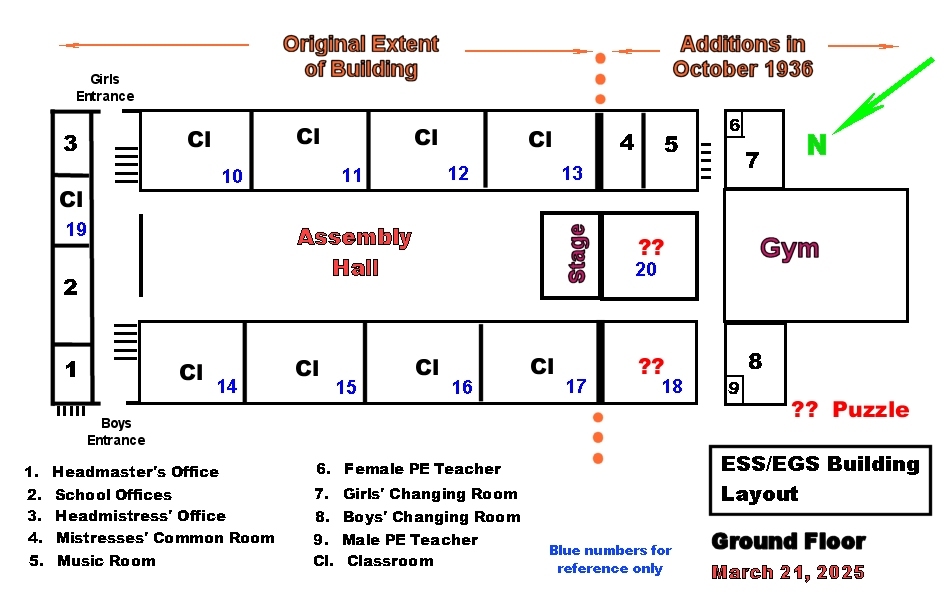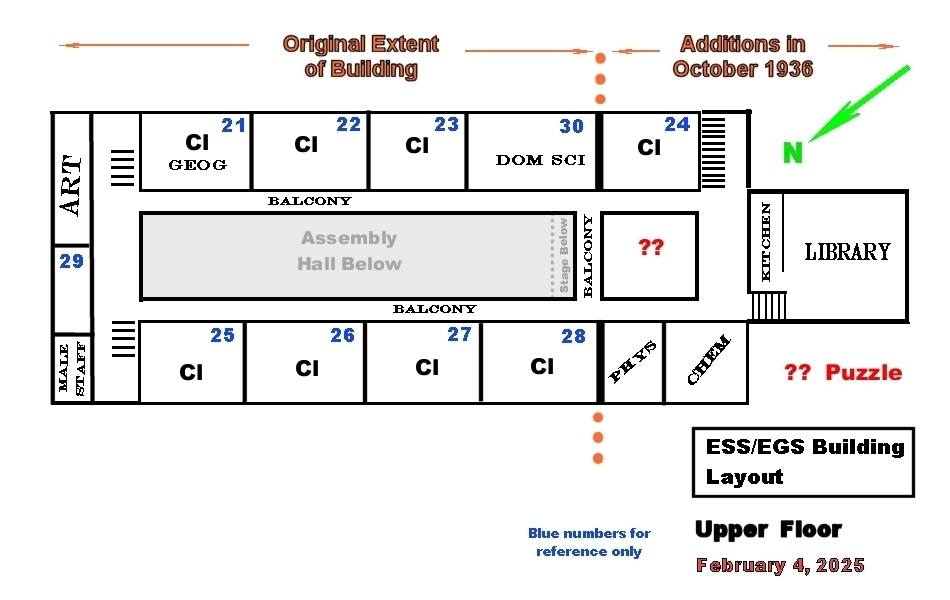The Eccles Grammar School: Rise and Fall
Revised 21 March, 2025. Written by Harry King (see Acknowledgements)
The Birth and Flower
The Education Act of 1902 authorised County Councils to make provision for Secondary Education. The "Eccles Secondary School" was the first result in Lancashire of this new order. On the fifth of September, 1911, the School was opened with 95 pupils, and with Mr. Thomas Inglefield Cowlishaw, M.A, as Headmaster, assisted by 3 mistresses, 3 masters, and 3 part-time teachers. Mr. Cowlishaw, then thirty-eight and known at TIC because of his initials, was a mathematician and had previously taught at the Salford Royal Technical Institute (1). The Senior Mistress was Edith Woollacott, a Salford woman who had also taught at Salford after getting her degree from London University. All teachers taught whatever subjects were required. Then, there was no library, there were no seats in the Hall, and no School meals. Games were played during the 1st year on a field at the bottom of Hawthorn Avenue. Very soon afterward, the sports field moved to the bottom end of Pine Grove.
Some of the teachers who came to the school within the first five years stayed there until the end of World War 2. Among the men were William Shercliff, John Gunter, and Arthur Hollis; among the women were Ida Petford and Minnie (or perhaps Mabel) Sefton. One pupil who attended the school during these earliest years (and later became a teacher at the school in 1949 and into the 1960's) was Dorothy (Cooper) Cannon. She attended 1915-1922 and upon leaving school got a First Class Honours degree in Latin at Manchester University in 1925.
In the early years, children entered the School at 12 years of age and left at 14. Some stayed to take the Manchester Matriculation in the Fifth Form, but only an occasional pupil stayed into the Sixth. There was no "A" Level, and what would later (in the 1960's) be termed as "Five at 'O' Level" was sufficient for University Entrance.
By the 1920's there were over 400 pupils in the School with 19 Staff, but only 6 boys and 26 girls were over 15 years of age. A fee was paid for School attendance: it was then about 2 guineas a term, but some students, about a quarter of the total, had scholarships. Rooms 13 and 14 ceased to be the Gym, and a corrugated iron hut appeared in the Girls' yard to take on that function. Pupils did not change into other clothes either for Gym or for Games. Even from these early years, pupils were gaining entrance to universities, mainly at Manchester.
A number of the teachers who came to the School in the years after WWI stayed for many years following – Mr. Alec Pearson (1926), Mr. John Ball (1928), Ms. Ethel Foster (1928), Ms. Beatrice Baker (1930). The former two had graduated from Manchester University after serving in WWI. The trend continued for increasing numbers of pupils to gain entrance to universities, including Oxford and Cambridge as well as Manchester.
In 1928/29 the Pavilion was built at the playing field, the Old Essian Association received its first official mention, and plans for expansion of the school were being made. In 1932 the cricket pitch was laid and a large amount of " dumping " took place to fill up the low places in the surrounding fields so that the Junior Pitch (later affectionately called the Rabbits in deference to the numerous occupants of the land) could be made.
On October 24th, 1936, Lord Derby opened extensions to the buildings. (See diagrams below, showing the lower and upper floors before and after the extension.) The Gym, Library, Mistress's Common Room., Music Room, 16, and the Advanced Physics and Chemistry Labs, came into use, and the stage became properly operative. About this time pupils started to be taken abroad for holidays -- the boys to camp, and the girls to Paris. Because the School was growing substantially, plans were also made to divide the School -- the girls were to have a new Girls' Grammar School at Swinton, and the boys were to remain at Eccles.


In 1937 Mr. Cowlishaw retired after 26 years as Headmaster. Mr. Fairweather came to take his place. In 1939 the War started. This caused the abandonment of plans to separate the school into a girls' school and a boys' school. There was a very long summer holiday, and air raid shelters came to be built. Drill routines came to be instituted, and a fire watch started in which staff and sixth-formers paraded the roof at night during air raids to deal with incendiary bombs. If there were no bombs, there was music to hear, and there were sausages to fry. During these years several of the teachers (including Mr Fairweather) were seconded into War service. When Mr Fairweather was away during the War, Mr. Gunter served as the Headmaster. From near the end of the War, large numbers of students began to stay for School dinners. In 1944 School fees were abolished, the name of the School changed from "Eccles Secondary School" to "Eccles Grammar School." Over 500 boys and girls served in the Forces in all parts of the world during the War, and 38 of them lost their lives.
The most striking development in the School after 1940 was the great growth of the Sixth Form. In response to the War, everyday life became more technical and more automated, and organisers and teachers became essential in the post-war organization of society. Pupils became used to the idea of staying longer at school, and of moving on to further education. In 1937 there had been less than ten pupils in the Sixth Form, but by the 1960's there were around eighty. The number of pupils in the School grew to around 650, and classrooms came to be built on the playground. Greater numbers of students were moving on to seek a university education.
In 1964, Mr. Fairweather retired after 27 years as Headmaster. A year later, Miss Baker, the Headmistress, who had been at the School since 1930, also retired. The new Headmaster was Mr. Keith McKewan, a graduate of Oxford. It was not long before plans were hatched to re-purpose and/or to close the School. Some of its prior functions were to be replaced by a "Sixth Form College". Mr McEwan became involved in the pre-planning of this College and left the School in December 1971 to take on the headship of the Sixth Form College. The Deputy Headmaster, Mr. Harry Miller (who had replaced Mr. Pearson in 1959), headed what remained of the School in the "old" building after McEwan's departure. In September, 1972, the new Eccles Sixth Form College was opened in a building in Ellesmere Park. Many of the more senior teachers from the old School, as well as some of the younger teachers, went there to carry on its traditions. Eccles Grammar School was taking its last breath.
The Disappearance and Reformulation
In 1973, "Grammar Schools" ceased to exist in Salford with the introduction into the district of "Comprehensive Schools" -- schools that did not select their intake on the basis of academic achievement or aptitude. (Comprehensive schools had first been introduced in England and Wales as a whole in 1965, and selective schools therefore continually declined in number across the country after that time.) The "old" Eccles Grammar School therefore dissolved in 1973. Its functions were taken over by two entities: (1) in part by the Ellesmere Park Secondary School (EPSS), with which the Grammar School amalgamated and became the Ellesmere Park High School (EPHS), catering to the 11-16 age group; and, (2) in part by the aforementioned Eccles Sixth Form College, for senior students. These two entities are described separately:
The Ellesmere Park High School
The main building of the EPHS was on Wentworth Road and it took over the education of junior students. EPSS had been formed in 1973 as a successor to the Ellesmere Park County High School (that had in turn formed in 1958). The Ellesmere Park High School inherited the old Grammar School building at Park Road/ Hawthorn Avenue (PR-HA) so that for a time in the 1970's its operations functioned on two sites -- the PR-HA building for 1st, 2nd and 3rd year students, and the existing Wentworth Road building for 4th and 5th year students. That arrangement didn't last for long. All EPHS students consolidated into the Wentworth Road building and the PR-HA building became disused and fell into neglect. In the early 1990's it got demolished and a private, gated apartment complex was built on its site, aptly named 'Old School Court'.
In 1987 Winton High School merged with Ellesmere Park High School and it was at that time that the EPHS changed its name to Wentworth High School. A new school was built on the playing field area of the Wentworth High School, and the school then transferred to there in 2014. It reverted its name again -- to the old name of Ellesmere Park High School.
Eccles Sixth Form College
It began life in 1973, as noted above, and it became referred to in a more colloquial way as just Eccles College -- a "Further Education" college. It was situated on Chatsworth Road. The sixth forms of both Eccles Grammar School and Wardley Grammar School provided the first intake of the College, and the staff were a mixture of those two schools, too. The principal of the College was Keith McEwan, and Vice Principals were Henry Miller and Elizabeth Nall, again transfers from the EGS.
The curriculum was much broader than that of the Sixth Form of the Grammar School that it had succeeded. Its coursework and experience prepared students not only for further work in academia (preparation for "A" levels and subsequent entrance to universities and to teacher training programs -- as had been done before), but also for careers outside traditional academia and of a more vocational nature, "skills improvement", and "personal development".
In 2009 the College was disbanded as a separate entity: it merged into Salford Community College (together with Pendleton College and Salford College) though retaining its name of 'Eccles Sixth Form College'. Its logo characterises it as "A centre of vocational excellence -- specialising in animal care, sport, and uniformed public services".
Acknowledgements
My seven-year experience at the School was in the 1950's, so I know nothing at first hand about its earlier years, nor its later ones. For that reason, I have three great debts: first, to a brief article about the early history of the School in the Essayan magazine in 1961, apparently penned by Mr. Fairweather, that celebrated the School's 50th anniversary; second, to the articles that appeared in the Eccles and Patricroft Journal in August 1973 that gave remembrances of the School at its closing; and third, to Ms. Britta Leonard of the Ellesmere Park High School who spent three of her school years as a student at the EGS "old building", 1975-1977, and who observed the closing of the School and the rise of its successors.
- (1). He had graduated with a B.A. and an M.A. (in 1905) from the Royal University of Ireland, Dublin. He had also published a textbook of mathematical examples in 1909.